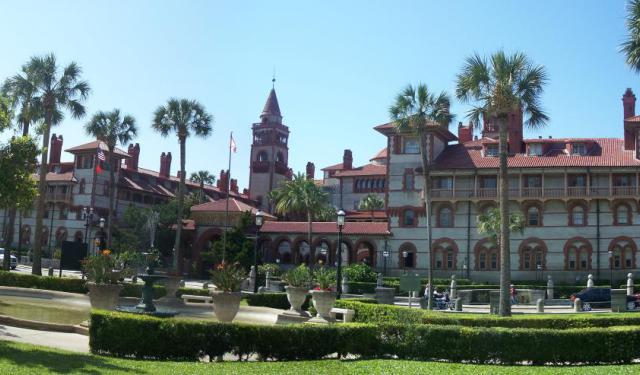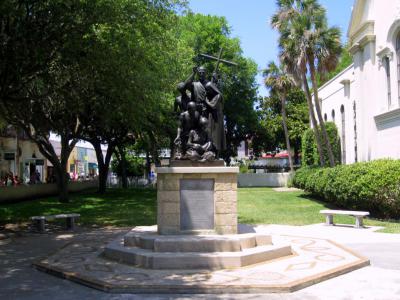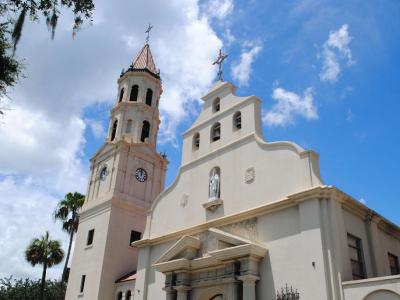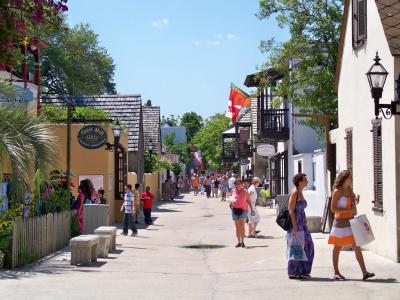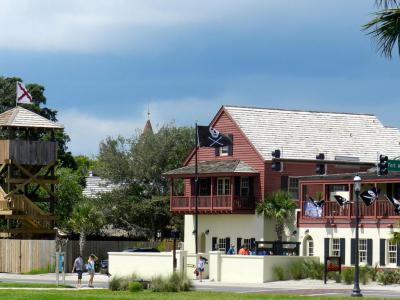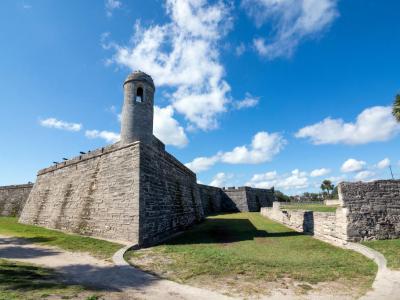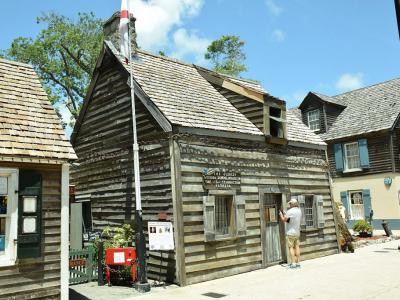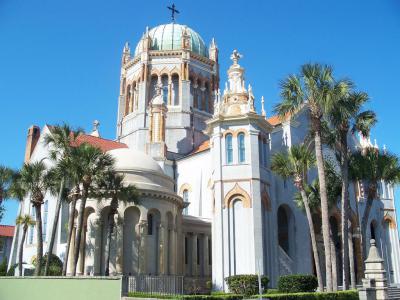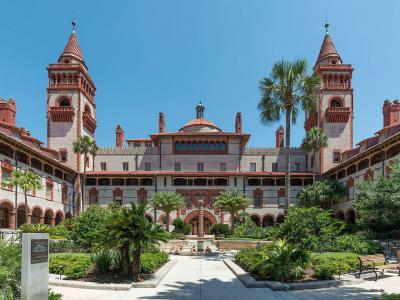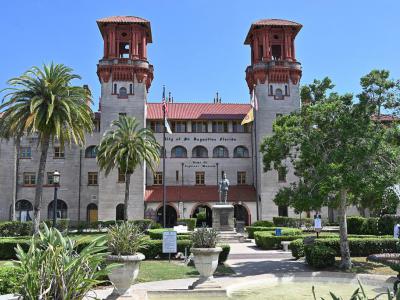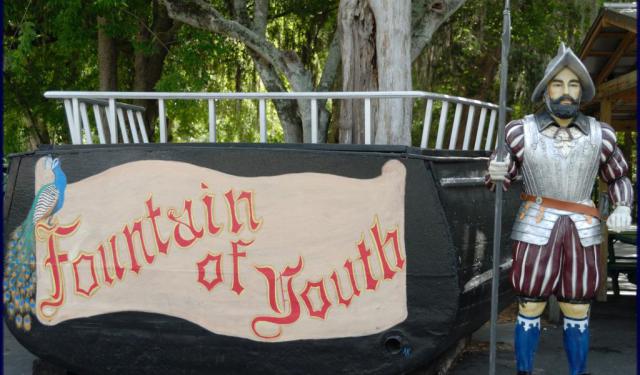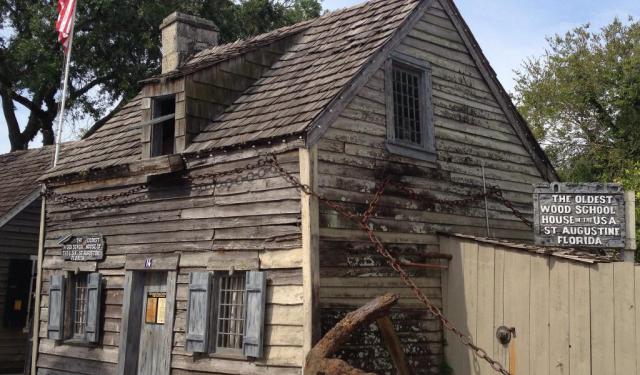Audio Guide: St. Augustine Introduction Walking Tour (Self Guided), St. Augustine
It is said that the first-ever Thanksgiving meal took place in 1565, when Spanish explorers led by Pedro Menéndez held a Catholic Mass and a communal meal with the Timucua people in what is now St. Augustine, Florida.
Poised on Florida’s northeastern coast, the city holds the distinction of being the oldest continuously inhabited European-founded settlement in the United States. Its story begins in 1565, when Spanish admiral Pedro Menéndez de Avilés arrived and named the settlement after Saint Augustine of Hippo. His fleet had sighted land on August 28, the saint’s feast day, and the name stuck. From the outset, this new outpost stood at the center of imperial rivalries, its survival tied to Spain’s determination to defend Florida against French and English ambitions.
Conflict came quickly. Just three years after its founding, French forces under Dominique de Gourgues attacked in 1568, but Spain held its ground. For more than two centuries afterward, St. Augustine served as the capital of Spanish Florida, its fortunes tied to empire and the sea. Protection was paramount, and in 1672 the Spanish began building what became Castillo de San Marcos (formerly known as St. Mark’s Castle). Finished in 1695 and made from local coquina stone, the fortress absorbed cannon fire instead of breaking apart-a clever twist of geology that helped it withstand sieges, pirate raids, and British assaults. Today, it still looms over the waterfront as the oldest surviving masonry fort in the continental U.S.
Religion kept pace with the cannons. Founded in 1565 as the earliest Catholic parish in the nation, the Cathedral Basilica of St. Augustine became the city’s spiritual anchor. The present building, completed in the late 18th century, shows off Spanish Colonial influence, and through centuries of changing rulers, it remained a constant thread of continuity.
Speaking of changes, the city was passed around like a hot potato. In 1763, Spain ceded Florida to Britain, and the town briefly became the capital of British East Florida. It returned to Spanish hands in 1783 before being passed to the United States in 1819 through the Adams–Onís Treaty. In 1821, it briefly served as the capital of the Florida Territory.
The city's commercial potential was not lost on savvy entrepreneurs. Industrialist Henry Flagler transformed St. Augustine into a winter oasis for the wealthy elite, leaving behind the sumptuous Ponce de León Hotel and other landmarks.
From Spanish garrisons to Flagler’s gilded hotels, St. Augustine has always been shaped by people chasing visions. As you walk its centuries-old streets, you'll trace the footsteps of explorers, settlers, soldiers, and dreamers. Take your time, explore at your own pace, and let the city's rich layers of history reveal themselves with every stop along the way.
Poised on Florida’s northeastern coast, the city holds the distinction of being the oldest continuously inhabited European-founded settlement in the United States. Its story begins in 1565, when Spanish admiral Pedro Menéndez de Avilés arrived and named the settlement after Saint Augustine of Hippo. His fleet had sighted land on August 28, the saint’s feast day, and the name stuck. From the outset, this new outpost stood at the center of imperial rivalries, its survival tied to Spain’s determination to defend Florida against French and English ambitions.
Conflict came quickly. Just three years after its founding, French forces under Dominique de Gourgues attacked in 1568, but Spain held its ground. For more than two centuries afterward, St. Augustine served as the capital of Spanish Florida, its fortunes tied to empire and the sea. Protection was paramount, and in 1672 the Spanish began building what became Castillo de San Marcos (formerly known as St. Mark’s Castle). Finished in 1695 and made from local coquina stone, the fortress absorbed cannon fire instead of breaking apart-a clever twist of geology that helped it withstand sieges, pirate raids, and British assaults. Today, it still looms over the waterfront as the oldest surviving masonry fort in the continental U.S.
Religion kept pace with the cannons. Founded in 1565 as the earliest Catholic parish in the nation, the Cathedral Basilica of St. Augustine became the city’s spiritual anchor. The present building, completed in the late 18th century, shows off Spanish Colonial influence, and through centuries of changing rulers, it remained a constant thread of continuity.
Speaking of changes, the city was passed around like a hot potato. In 1763, Spain ceded Florida to Britain, and the town briefly became the capital of British East Florida. It returned to Spanish hands in 1783 before being passed to the United States in 1819 through the Adams–Onís Treaty. In 1821, it briefly served as the capital of the Florida Territory.
The city's commercial potential was not lost on savvy entrepreneurs. Industrialist Henry Flagler transformed St. Augustine into a winter oasis for the wealthy elite, leaving behind the sumptuous Ponce de León Hotel and other landmarks.
From Spanish garrisons to Flagler’s gilded hotels, St. Augustine has always been shaped by people chasing visions. As you walk its centuries-old streets, you'll trace the footsteps of explorers, settlers, soldiers, and dreamers. Take your time, explore at your own pace, and let the city's rich layers of history reveal themselves with every stop along the way.
How it works: Download the app "GPSmyCity: Walks in 1K+ Cities" from Apple App Store or Google Play Store to your mobile phone or tablet. The app turns your mobile device into a personal tour guide and its built-in GPS navigation functions guide you from one tour stop to next. The app works offline, so no data plan is needed when traveling abroad.
St. Augustine Introduction Walking Tour Map
Guide Name: St. Augustine Introduction Walking Tour
Guide Location: USA » St. Augustine (See other walking tours in St. Augustine)
Guide Type: Self-guided Walking Tour (Sightseeing)
# of Attractions: 9
Tour Duration: 2 Hour(s)
Travel Distance: 2.5 Km or 1.6 Miles
Author: DanaOffice
Sight(s) Featured in This Guide:
Guide Location: USA » St. Augustine (See other walking tours in St. Augustine)
Guide Type: Self-guided Walking Tour (Sightseeing)
# of Attractions: 9
Tour Duration: 2 Hour(s)
Travel Distance: 2.5 Km or 1.6 Miles
Author: DanaOffice
Sight(s) Featured in This Guide:
- Plaza de la Constitución (Constitution Square)
- Cathedral Basilica of St. Augustine
- St. George Street
- St. Augustine Pirate and Treasure Museum
- Castillo de San Marcos (St. Mark's Castle)
- Oldest Wooden Schoolhouse
- Memorial Presbyterian Church
- Ponce de Leon Hotel and Flagler College Building
- Lightner Museum
1) Plaza de la Constitución (Constitution Square)
Constitution Square in St. Augustine is no ordinary patch of grass-it’s the oldest public space in the United States, first laid out in 1573 by Spanish colonists who followed their familiar town-planning playbook: a plaza at the center for worship, politics, and daily life. For nearly 450 years, this rectangle of land has absorbed the city’s routine chatter and its most dramatic turning points, making it the stage where St. Augustine’s story has unfolded.
At its center rises the Constitution Monument, placed here in 1813 to honor Spain’s short-lived liberal charter of 1812. Remarkably, it still stands, making it the oldest surviving U.S. monument tied to constitutional government. That’s not the only marker of civic memory-another addition, the Foot Soldiers Monument from 2011, honors the civil rights activists of the 1960s who changed the course of the city’s modern identity. Walk a little farther east, and you’ll reach the Public Market Place, first established in 1598. It bustled with food and goods by the 19th century but also carries the darker memory of having served as a slave market. Its pavilion still operates as a market today, a quiet link between past commerce and present life.
The square is ringed by some of St. Augustine’s heaviest hitters: the Cathedral Basilica, the nation’s oldest Catholic parish, still standing as a spiritual anchor, and within sight, the Saint Mark's Castle, the Spanish fort that once protected the city from invaders. Cannons dot the plaza, a public well recalls earlier days, and paths shaded by palms invite pause.
Constitution Square remains both a crossroads and a reminder: a park where families gather, concerts play, and festivals spill into the night, all on the same ground where centuries of faith, trade, and struggle have left their mark.
At its center rises the Constitution Monument, placed here in 1813 to honor Spain’s short-lived liberal charter of 1812. Remarkably, it still stands, making it the oldest surviving U.S. monument tied to constitutional government. That’s not the only marker of civic memory-another addition, the Foot Soldiers Monument from 2011, honors the civil rights activists of the 1960s who changed the course of the city’s modern identity. Walk a little farther east, and you’ll reach the Public Market Place, first established in 1598. It bustled with food and goods by the 19th century but also carries the darker memory of having served as a slave market. Its pavilion still operates as a market today, a quiet link between past commerce and present life.
The square is ringed by some of St. Augustine’s heaviest hitters: the Cathedral Basilica, the nation’s oldest Catholic parish, still standing as a spiritual anchor, and within sight, the Saint Mark's Castle, the Spanish fort that once protected the city from invaders. Cannons dot the plaza, a public well recalls earlier days, and paths shaded by palms invite pause.
Constitution Square remains both a crossroads and a reminder: a park where families gather, concerts play, and festivals spill into the night, all on the same ground where centuries of faith, trade, and struggle have left their mark.
2) Cathedral Basilica of St. Augustine
The Cathedral Basilica of St. Augustine holds centuries of Florida’s layered past in its walls. Its story begins in 1565, when Pedro Avilés founded the settlement and set up the first parish. That early church didn’t survive the centuries of fires and skirmishes that followed, but the one you see today was begun in the 1790s, finished in 1797, and then rebuilt after an 1887 blaze with the financial help of Henry Flagler, the railroad tycoon who reshaped much of Florida. Through Spanish, British, and American turns of rule, the cathedral remained a constant, a center of worship and identity. Recognition of that weight came later, when Pope Paul VI raised it to basilica status in 1976, after it had already been named a National Historic Landmark in 1970.
Its architecture reflects both resilience and ambition. The façade, of pale coquina stone capped with red tile, is a blend of Spanish Colonial roots and Neoclassical refinement. Twin bell towers and arched windows point to Mediterranean influences, while inside the drama unfolds in color and form: a red open-timbered ceiling crossed with decorated beams, walls lined with murals narrating Catholic missions in Florida, and a high altar that gleams in white and gold. Light filters through stained glass, while the music of two grand organs-the Casavant Frères and the Colby-Walker-fills the nave. Side chapels, frescoes, and relics trace a continuous line of devotion stretching back to the city’s founding.
For today’s visitor, the cathedral is more than an architectural jewel. Sitting across from Constitution Square and within sight of Saint Mark's Castle, it ties together the city’s story of empire, defense, and faith. Stepping inside offers a pause from the busy streets outside, but also a chance to feel the endurance of a community that has prayed, gathered, and rebuilt here for more than four centuries.
Its architecture reflects both resilience and ambition. The façade, of pale coquina stone capped with red tile, is a blend of Spanish Colonial roots and Neoclassical refinement. Twin bell towers and arched windows point to Mediterranean influences, while inside the drama unfolds in color and form: a red open-timbered ceiling crossed with decorated beams, walls lined with murals narrating Catholic missions in Florida, and a high altar that gleams in white and gold. Light filters through stained glass, while the music of two grand organs-the Casavant Frères and the Colby-Walker-fills the nave. Side chapels, frescoes, and relics trace a continuous line of devotion stretching back to the city’s founding.
For today’s visitor, the cathedral is more than an architectural jewel. Sitting across from Constitution Square and within sight of Saint Mark's Castle, it ties together the city’s story of empire, defense, and faith. Stepping inside offers a pause from the busy streets outside, but also a chance to feel the endurance of a community that has prayed, gathered, and rebuilt here for more than four centuries.
3) St. George Street (must see)
St. George Street runs through the historic heart of St. Augustine like a timeline you can walk. Laid out in the 16th century by Spanish colonists, it was the backbone of the fortified town, a place where daily life unfolded in houses of coquina stone, in taverns alive with voices, and in small shops trading under both Spanish and British flags. More than 450 years later, the old grid is still there, but now it mixes the weight of history with the hum of cafés, boutiques, and music drifting from open doorways.
Landmarks anchor the walk. The Pena-Peck House, built in 1750, still stands, now home to the Woman’s Exchange of St. Augustine. The Colonial Quarter acts as a living history museum, with demonstrations that bring 18th-century crafts and traditions to life. And then there’s the Oldest Wooden Schoolhouse, a creaky survivor that reminds visitors of early American education. Together with the 18th-century coquina houses, these buildings preserve the look and feel of the colonial street. Beyond them, St. George connects seamlessly to the Cathedral Basilica of St. Augustine and to the looming Saint Mark's Castle, tying commerce, faith, and defense into one shared story.
The street is pedestrian-only through its busiest stretch, making it a promenade of galleries, restaurants, and street performers. Unusual attractions like the Medieval Torture Museum add a twist, while seasonal events spill into the thoroughfare with music and crowds. The route ends at the 1739 city gate, said by some to be haunted, a fitting close to a street that has seen centuries of life, conflict, and change.
St. George Street may be lined with ice cream shops and souvenir stalls today, but beneath it all lies a colonial backbone that has shaped St. Augustine since its earliest days. It remains the city’s most engaging walk, where history and modern life intersect step by step.
Landmarks anchor the walk. The Pena-Peck House, built in 1750, still stands, now home to the Woman’s Exchange of St. Augustine. The Colonial Quarter acts as a living history museum, with demonstrations that bring 18th-century crafts and traditions to life. And then there’s the Oldest Wooden Schoolhouse, a creaky survivor that reminds visitors of early American education. Together with the 18th-century coquina houses, these buildings preserve the look and feel of the colonial street. Beyond them, St. George connects seamlessly to the Cathedral Basilica of St. Augustine and to the looming Saint Mark's Castle, tying commerce, faith, and defense into one shared story.
The street is pedestrian-only through its busiest stretch, making it a promenade of galleries, restaurants, and street performers. Unusual attractions like the Medieval Torture Museum add a twist, while seasonal events spill into the thoroughfare with music and crowds. The route ends at the 1739 city gate, said by some to be haunted, a fitting close to a street that has seen centuries of life, conflict, and change.
St. George Street may be lined with ice cream shops and souvenir stalls today, but beneath it all lies a colonial backbone that has shaped St. Augustine since its earliest days. It remains the city’s most engaging walk, where history and modern life intersect step by step.
4) St. Augustine Pirate and Treasure Museum
Across the street from the stone bulk of Saint Mark's Castle sits a museum that swaps cannon fire for cutlasses-the St. Augustine Pirate and Treasure Museum. It didn’t start here; collector Pat Croce first opened it in Key West, but in 2010 it found its natural harbor in the nation’s oldest city, right where real raiders once tested Spain’s defenses. Its focus is the so-called Golden Age of Piracy, the 17th and 18th centuries, a time when the likes of Sir Francis Drake and Robert Searle were more than names in books-they were menacing the very coast of Florida. Drake even torched St. Augustine in 1586, leaving a scar that still lingers in the city’s memory.
Inside, the museum holds one of the most extensive pirate collections in the world-more than 800 artifacts ranging from navigational charts and ivory compasses to Blackbeard memorabilia. Standouts include one of the few surviving Jolly Roger flags and Captain Kidd’s heavy, iron-bound treasure chest, the last of its kind. There are also fragments from Drake’s own ship, relics that tie global seafaring drama directly back to St. Augustine’s shoreline.
The experience doesn’t stop at glass cases. Guests can fire a replica cannon, puzzle out sailor’s knots, and step into below-deck recreations that bring the smell, sound, and claustrophobic feel of ship life into sharp focus. Life-size figures, lashings, and even “guess-the-cargo-by-smell” challenges make sure the visit is more than passive observation.
By blending real artifacts with theatrical staging, the museum bridges myth and history, showing piracy’s glamour and brutality side by side. For St. Augustine, it adds another layer to the city’s story-one where empire, treasure, and violence converged on Florida’s shores. A stroll through its halls complements the nearby fortress and cathedral, rounding out the tale of how this small port stood at the edge of the world’s great rivalries.
Inside, the museum holds one of the most extensive pirate collections in the world-more than 800 artifacts ranging from navigational charts and ivory compasses to Blackbeard memorabilia. Standouts include one of the few surviving Jolly Roger flags and Captain Kidd’s heavy, iron-bound treasure chest, the last of its kind. There are also fragments from Drake’s own ship, relics that tie global seafaring drama directly back to St. Augustine’s shoreline.
The experience doesn’t stop at glass cases. Guests can fire a replica cannon, puzzle out sailor’s knots, and step into below-deck recreations that bring the smell, sound, and claustrophobic feel of ship life into sharp focus. Life-size figures, lashings, and even “guess-the-cargo-by-smell” challenges make sure the visit is more than passive observation.
By blending real artifacts with theatrical staging, the museum bridges myth and history, showing piracy’s glamour and brutality side by side. For St. Augustine, it adds another layer to the city’s story-one where empire, treasure, and violence converged on Florida’s shores. A stroll through its halls complements the nearby fortress and cathedral, rounding out the tale of how this small port stood at the edge of the world’s great rivalries.
5) Castillo de San Marcos (St. Mark's Castle) (must see)
St. Mark’s Castle rises on the waterfront as St. Augustine’s unmistakable stronghold. Its origins go back to the late 1600s, when Spain had grown tired of watching pirates and English raiders torch its wooden forts like kindling. In 1672, the crown ordered something more permanent, and for over two decades crews quarried and stacked blocks of coquina-the seashell-based limestone unique to Florida’s coast. The result was a fortress that seemed almost alive: cannonballs would sink into its walls rather than shatter them, leaving the stone pockmarked but intact. By 1695, the Castillo was finished, and for the first time St. Augustine had a defense that endured.
The centuries that followed tested those walls again and again. British sieges, pirate raids, and shifting colonial rivalries all passed, but the fort never fell. When Florida was ceded to Britain in 1763, the stronghold was renamed Fort St. Mark; two decades later it returned to Spain, and by 1821 the United States claimed it, rechristening it Fort Marion. In the 19th century it was used less as a fortress and more as a prison, including for Seminole leaders during the wars that followed U.S. expansion. By 1900 the military no longer needed it, but its stone walls remained unbroken.
Nowadays the Castle is a National Monument, its Spanish name restored in 1942. Visitors can cross the drawbridge into its sally port, walk through rooms once used as barracks or storerooms, and climb to the gun deck for sweeping views of the bay. Reenactments and exhibits explain what life was like for soldiers who kept watch here centuries ago. For nearly 350 years, the Castillo has outlasted empires and served as St. Augustine’s most enduring witness to the struggles and ambitions that shaped Florida’s coast.
The centuries that followed tested those walls again and again. British sieges, pirate raids, and shifting colonial rivalries all passed, but the fort never fell. When Florida was ceded to Britain in 1763, the stronghold was renamed Fort St. Mark; two decades later it returned to Spain, and by 1821 the United States claimed it, rechristening it Fort Marion. In the 19th century it was used less as a fortress and more as a prison, including for Seminole leaders during the wars that followed U.S. expansion. By 1900 the military no longer needed it, but its stone walls remained unbroken.
Nowadays the Castle is a National Monument, its Spanish name restored in 1942. Visitors can cross the drawbridge into its sally port, walk through rooms once used as barracks or storerooms, and climb to the gun deck for sweeping views of the bay. Reenactments and exhibits explain what life was like for soldiers who kept watch here centuries ago. For nearly 350 years, the Castillo has outlasted empires and served as St. Augustine’s most enduring witness to the struggles and ambitions that shaped Florida’s coast.
6) Oldest Wooden Schoolhouse
The Oldest Wooden Schoolhouse on St. George Street doesn’t need a fancy name-it tells you exactly what it is. Records show it on the tax rolls by 1716, making it the oldest surviving wooden school building in the country, born under Spanish colonial rule. Built from bald cypress and red cedar, fastened with hand-forged nails and wooden pegs, it doubled as both classroom and home-the schoolmaster lived upstairs while his students filled the benches below.
In 1780, Minorcan immigrant Juan Genopoly bought the property and gave it new life as both homestead and schoolroom. He and his family taught the basics-reading, writing, arithmetic, and religion-to children of Spanish settlers, Minorcan families, and others who made up St. Augustine’s diverse community. The last class graduated in 1864, and since then the little building, sometimes called the “Genopoly House,” has stood as a rare witness to colonial education in Florida.
Today, it works less as a classroom and more as a time capsule. Step inside and you’ll find the small wooden desks, old textbooks, and even animatronic students keeping the lesson alive. A detached kitchen, a modest garden, and the so-called “dungeon” for unruly pupils round out the tour. Look closely outside and you’ll see heavy iron chains, added in the 1930s to keep hurricanes from carrying the place off.
For visitors, the schoolhouse is a quick but fascinating stop-part curiosity, part museum-that brings St. Augustine’s centuries of history down to the scale of a single room where children once learned their letters.
In 1780, Minorcan immigrant Juan Genopoly bought the property and gave it new life as both homestead and schoolroom. He and his family taught the basics-reading, writing, arithmetic, and religion-to children of Spanish settlers, Minorcan families, and others who made up St. Augustine’s diverse community. The last class graduated in 1864, and since then the little building, sometimes called the “Genopoly House,” has stood as a rare witness to colonial education in Florida.
Today, it works less as a classroom and more as a time capsule. Step inside and you’ll find the small wooden desks, old textbooks, and even animatronic students keeping the lesson alive. A detached kitchen, a modest garden, and the so-called “dungeon” for unruly pupils round out the tour. Look closely outside and you’ll see heavy iron chains, added in the 1930s to keep hurricanes from carrying the place off.
For visitors, the schoolhouse is a quick but fascinating stop-part curiosity, part museum-that brings St. Augustine’s centuries of history down to the scale of a single room where children once learned their letters.
7) Memorial Presbyterian Church
Memorial Presbyterian Church in St. Augustine is less a quiet corner of worship and more a monumental reminder of how one man reshaped an entire city. Industrialist Henry Flagler, best known as co-founder of Standard Oil and architect of Florida’s Gilded Age boom, had it built in 1889 after the death of his daughter, Jenny Louise Benedict. Finished the following year, the church was meant as a memorial, but also became Flagler’s own final resting place-his mausoleum lies here alongside his wife, daughter, and granddaughter.
Architects Carrère and Hastings, the same team behind Flagler’s luxury hotels, designed the church in Venetian Renaissance Revival style, with clear inspiration drawn from Venice’s Saint Mark’s Basilica. Its 150-foot copper dome, turquoise against the Florida sky, makes it one of the most recognizable silhouettes in St. Augustine. The façade mixes coquina stone and terra cotta trim, while a rose window and triple-arched portico give the entrance an Italianate grandeur that feels as much about ambition as faith.
Step inside and the impression deepens. Marble flooring, mahogany pews, and stained glass windows depicting biblical scenes create a space where craftsmanship speaks loudly. The interior is rich with mosaics, murals, and intricate woodwork, while the Skinner pipe organ adds its own voice to the grandeur. Every detail reflects Flagler’s determination to leave behind more than railroads and hotels-something permanent, solemn, and beautiful.
The Memorial Presbyterian Church remains an active congregation and a landmark that bridges spiritual life with the story of St. Augustine’s transformation. For visitors, it’s a chance to admire a dome that rivals Venice, marvel at stained glass awash with Florida light, and stand in the place where Henry Flagler, the man who reimagined the city, chose to rest. It’s as much a chapter of history as it is a place of worship.
Architects Carrère and Hastings, the same team behind Flagler’s luxury hotels, designed the church in Venetian Renaissance Revival style, with clear inspiration drawn from Venice’s Saint Mark’s Basilica. Its 150-foot copper dome, turquoise against the Florida sky, makes it one of the most recognizable silhouettes in St. Augustine. The façade mixes coquina stone and terra cotta trim, while a rose window and triple-arched portico give the entrance an Italianate grandeur that feels as much about ambition as faith.
Step inside and the impression deepens. Marble flooring, mahogany pews, and stained glass windows depicting biblical scenes create a space where craftsmanship speaks loudly. The interior is rich with mosaics, murals, and intricate woodwork, while the Skinner pipe organ adds its own voice to the grandeur. Every detail reflects Flagler’s determination to leave behind more than railroads and hotels-something permanent, solemn, and beautiful.
The Memorial Presbyterian Church remains an active congregation and a landmark that bridges spiritual life with the story of St. Augustine’s transformation. For visitors, it’s a chance to admire a dome that rivals Venice, marvel at stained glass awash with Florida light, and stand in the place where Henry Flagler, the man who reimagined the city, chose to rest. It’s as much a chapter of history as it is a place of worship.
8) Ponce de Leon Hotel and Flagler College Building (must see)
The Ponce de Leon Hotel opened in 1888 as Henry Flagler’s grand statement that St. Augustine could rival Europe’s finest resorts. Flagler, co-founder of Standard Oil and architect of much of modern Florida, wanted a winter palace for the wealthy northerners arriving on his railroads. What he built was more than a hotel-it was a prototype for the Gilded Age resort, designed by Carrère and Hastings in Spanish Renaissance Revival style, and among the first American buildings to be made entirely of poured concrete mixed with local coquina shells.
“The Ponce,” as it quickly became known, dazzled with amenities few had ever seen. Edison himself wired it for electricity-over 4,000 lights illuminating a structure that also offered steam heat and running water. Inside, the experience was curated like theater: marble floors underfoot, grand murals by George W. Maynard and Virgilio Tojetti overhead, and dining halls glowing with stained glass and mosaics by Louis Comfort Tiffany. Politicians, writers, and sportsmen passed through its doors, stamping St. Augustine as a true resort city.
But fortunes shift. During World War II, the building served the Coast Guard Reserve. Declining tourism closed the hotel in 1967, and the next year, the structure took on a second life as the heart of Flagler College, a small liberal arts school that still thrives within its walls.
The Ponce de Leon-recognized as a National Historic Landmark since 2006-anchors the campus and remains open to visitors. Guided tours show off Tiffany’s glass, Tojetti’s murals, and the palmed courtyard where the Gilded Age still lingers. Flagler’s hotel lives on, not as a relic, but as a place where students study under domes and towers once meant to impress the world’s elite.
“The Ponce,” as it quickly became known, dazzled with amenities few had ever seen. Edison himself wired it for electricity-over 4,000 lights illuminating a structure that also offered steam heat and running water. Inside, the experience was curated like theater: marble floors underfoot, grand murals by George W. Maynard and Virgilio Tojetti overhead, and dining halls glowing with stained glass and mosaics by Louis Comfort Tiffany. Politicians, writers, and sportsmen passed through its doors, stamping St. Augustine as a true resort city.
But fortunes shift. During World War II, the building served the Coast Guard Reserve. Declining tourism closed the hotel in 1967, and the next year, the structure took on a second life as the heart of Flagler College, a small liberal arts school that still thrives within its walls.
The Ponce de Leon-recognized as a National Historic Landmark since 2006-anchors the campus and remains open to visitors. Guided tours show off Tiffany’s glass, Tojetti’s murals, and the palmed courtyard where the Gilded Age still lingers. Flagler’s hotel lives on, not as a relic, but as a place where students study under domes and towers once meant to impress the world’s elite.
9) Lightner Museum (must see)
Step into the Lightner Museum, and you’re really stepping into two stories at once: the grand ambitions of Henry Flagler and the quirky passions of Otto Lightner. The building itself began life as the Hotel Alcazar, Flagler’s 1888 answer to the winter blues of America’s wealthy elite. Designed by Carrère and Hastings in full Spanish Renaissance Revival style, it was every bit the Gilded Age showpiece-red-tiled roofs, soaring towers, and a list of luxuries that included a Turkish bath, a casino, tennis courts, and the world’s largest indoor swimming pool. For a while, St. Augustine glittered as a playground of the rich, thanks to Flagler’s railroads delivering them south. But when the Great Depression rolled in, the Alcazar’s doors closed, leaving its opulence to gather dust.
Enter Otto C. Lightner, a Chicago publisher with a taste for collecting the odd, the fine, and the downright extravagant. In 1948 he bought the abandoned hotel and crammed it with treasures salvaged from Gilded Age mansions-everything from Tiffany lamps and stained glass to mechanical musical instruments, cut-glass crystal, oil paintings, Victorian fashions, seashells, and even curiosities that make you wonder what estate sale he was bidding at.
The Lightner Museum spans three floors, and the building itself feels as much a part of the collection as the artifacts inside. Visitors wander through its soaring halls and leafy courtyard before stepping into exhibits that swing between high art and eclectic oddities. Tiffany’s stained glass glows alongside Victorian gowns; mechanical instruments hum a note of nostalgia; and tucked into what was once that massive pool is now Café Alcazar, where lunch comes with a side of Gilded Age grandeur.
For anyone exploring St. Augustine, the Lightner Museum offers a double delight: the over-the-top architecture of Flagler’s resort dream, and the eclectic, sometimes eccentric tastes of a collector who couldn’t bear to let the Gilded Age slip away.
Enter Otto C. Lightner, a Chicago publisher with a taste for collecting the odd, the fine, and the downright extravagant. In 1948 he bought the abandoned hotel and crammed it with treasures salvaged from Gilded Age mansions-everything from Tiffany lamps and stained glass to mechanical musical instruments, cut-glass crystal, oil paintings, Victorian fashions, seashells, and even curiosities that make you wonder what estate sale he was bidding at.
The Lightner Museum spans three floors, and the building itself feels as much a part of the collection as the artifacts inside. Visitors wander through its soaring halls and leafy courtyard before stepping into exhibits that swing between high art and eclectic oddities. Tiffany’s stained glass glows alongside Victorian gowns; mechanical instruments hum a note of nostalgia; and tucked into what was once that massive pool is now Café Alcazar, where lunch comes with a side of Gilded Age grandeur.
For anyone exploring St. Augustine, the Lightner Museum offers a double delight: the over-the-top architecture of Flagler’s resort dream, and the eclectic, sometimes eccentric tastes of a collector who couldn’t bear to let the Gilded Age slip away.
Walking Tours in St. Augustine, Florida
Create Your Own Walk in St. Augustine
Creating your own self-guided walk in St. Augustine is easy and fun. Choose the city attractions that you want to see and a walk route map will be created just for you. You can even set your hotel as the start point of the walk.
St. Augustine Early Settlements Tour
The city of St. Augustine on the northeastern coast of Florida is considered the oldest continuously occupied European settlement in the United States. It was founded by Spanish explorer Don Pedro Menendez de Aviles on September 8, 1565, and served as the capital of Spanish Florida for more than 200 years.
One of the most significant early European sites in the city is the Castillo de San... view more
Tour Duration: 1 Hour(s)
Travel Distance: 2.1 Km or 1.3 Miles
One of the most significant early European sites in the city is the Castillo de San... view more
Tour Duration: 1 Hour(s)
Travel Distance: 2.1 Km or 1.3 Miles
St. Augustine's Historical Houses Tour
A great deal of St. Augustine's storied past is set in stone in the form of houses that have been inhabited for over 400 years. The number of historic homes found in the city offer a glimpse into its colorful culture with European roots.
Among the most notable of them is the Ximenez-Fatio House. Built in 1798, originally as a boarding place for wealthy travelers, today this property serves... view more
Tour Duration: 1 Hour(s)
Travel Distance: 2.1 Km or 1.3 Miles
Among the most notable of them is the Ximenez-Fatio House. Built in 1798, originally as a boarding place for wealthy travelers, today this property serves... view more
Tour Duration: 1 Hour(s)
Travel Distance: 2.1 Km or 1.3 Miles
The Most Popular Cities
/ view all
